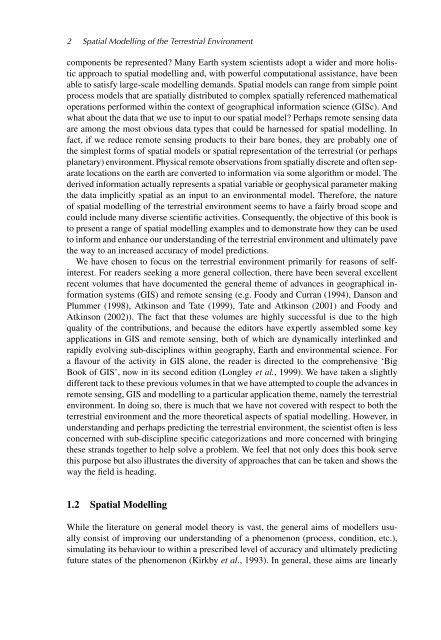1 Spatial Modelling of the Terrestrial Environment - Georeferencial
1 Spatial Modelling of the Terrestrial Environment - Georeferencial
1 Spatial Modelling of the Terrestrial Environment - Georeferencial
Create successful ePaper yourself
Turn your PDF publications into a flip-book with our unique Google optimized e-Paper software.
2 <strong>Spatial</strong> <strong>Modelling</strong> <strong>of</strong> <strong>the</strong> <strong>Terrestrial</strong> <strong>Environment</strong><br />
components be represented? Many Earth system scientists adopt a wider and more holistic<br />
approach to spatial modelling and, with powerful computational assistance, have been<br />
able to satisfy large-scale modelling demands. <strong>Spatial</strong> models can range from simple point<br />
process models that are spatially distributed to complex spatially referenced ma<strong>the</strong>matical<br />
operations performed within <strong>the</strong> context <strong>of</strong> geographical information science (GISc). And<br />
what about <strong>the</strong> data that we use to input to our spatial model? Perhaps remote sensing data<br />
are among <strong>the</strong> most obvious data types that could be harnessed for spatial modelling. In<br />
fact, if we reduce remote sensing products to <strong>the</strong>ir bare bones, <strong>the</strong>y are probably one <strong>of</strong><br />
<strong>the</strong> simplest forms <strong>of</strong> spatial models or spatial representation <strong>of</strong> <strong>the</strong> terrestrial (or perhaps<br />
planetary) environment. Physical remote observations from spatially discrete and <strong>of</strong>ten separate<br />
locations on <strong>the</strong> earth are converted to information via some algorithm or model. The<br />
derived information actually represents a spatial variable or geophysical parameter making<br />
<strong>the</strong> data implicitly spatial as an input to an environmental model. Therefore, <strong>the</strong> nature<br />
<strong>of</strong> spatial modelling <strong>of</strong> <strong>the</strong> terrestrial environment seems to have a fairly broad scope and<br />
could include many diverse scientific activities. Consequently, <strong>the</strong> objective <strong>of</strong> this book is<br />
to present a range <strong>of</strong> spatial modelling examples and to demonstrate how <strong>the</strong>y can be used<br />
to inform and enhance our understanding <strong>of</strong> <strong>the</strong> terrestrial environment and ultimately pave<br />
<strong>the</strong> way to an increased accuracy <strong>of</strong> model predictions.<br />
We have chosen to focus on <strong>the</strong> terrestrial environment primarily for reasons <strong>of</strong> selfinterest.<br />
For readers seeking a more general collection, <strong>the</strong>re have been several excellent<br />
recent volumes that have documented <strong>the</strong> general <strong>the</strong>me <strong>of</strong> advances in geographical information<br />
systems (GIS) and remote sensing (e.g. Foody and Curran (1994), Danson and<br />
Plummer (1998), Atkinson and Tate (1999), Tate and Atkinson (2001) and Foody and<br />
Atkinson (2002)). The fact that <strong>the</strong>se volumes are highly successful is due to <strong>the</strong> high<br />
quality <strong>of</strong> <strong>the</strong> contributions, and because <strong>the</strong> editors have expertly assembled some key<br />
applications in GIS and remote sensing, both <strong>of</strong> which are dynamically interlinked and<br />
rapidly evolving sub-disciplines within geography, Earth and environmental science. For<br />
a flavour <strong>of</strong> <strong>the</strong> activity in GIS alone, <strong>the</strong> reader is directed to <strong>the</strong> comprehensive ‘Big<br />
Book <strong>of</strong> GIS’, now in its second edition (Longley et al., 1999). We have taken a slightly<br />
different tack to <strong>the</strong>se previous volumes in that we have attempted to couple <strong>the</strong> advances in<br />
remote sensing, GIS and modelling to a particular application <strong>the</strong>me, namely <strong>the</strong> terrestrial<br />
environment. In doing so, <strong>the</strong>re is much that we have not covered with respect to both <strong>the</strong><br />
terrestrial environment and <strong>the</strong> more <strong>the</strong>oretical aspects <strong>of</strong> spatial modelling. However, in<br />
understanding and perhaps predicting <strong>the</strong> terrestrial environment, <strong>the</strong> scientist <strong>of</strong>ten is less<br />
concerned with sub-discipline specific categorizations and more concerned with bringing<br />
<strong>the</strong>se strands toge<strong>the</strong>r to help solve a problem. We feel that not only does this book serve<br />
this purpose but also illustrates <strong>the</strong> diversity <strong>of</strong> approaches that can be taken and shows <strong>the</strong><br />
way <strong>the</strong> field is heading.<br />
1.2 <strong>Spatial</strong> <strong>Modelling</strong><br />
While <strong>the</strong> literature on general model <strong>the</strong>ory is vast, <strong>the</strong> general aims <strong>of</strong> modellers usually<br />
consist <strong>of</strong> improving our understanding <strong>of</strong> a phenomenon (process, condition, etc.),<br />
simulating its behaviour to within a prescribed level <strong>of</strong> accuracy and ultimately predicting<br />
future states <strong>of</strong> <strong>the</strong> phenomenon (Kirkby et al., 1993). In general, <strong>the</strong>se aims are linearly

















